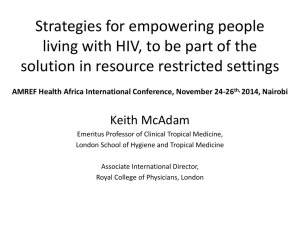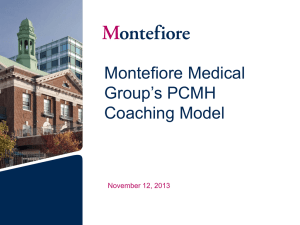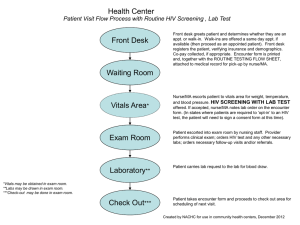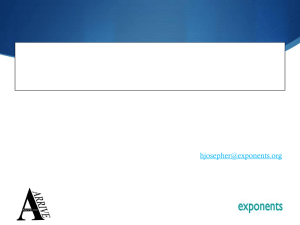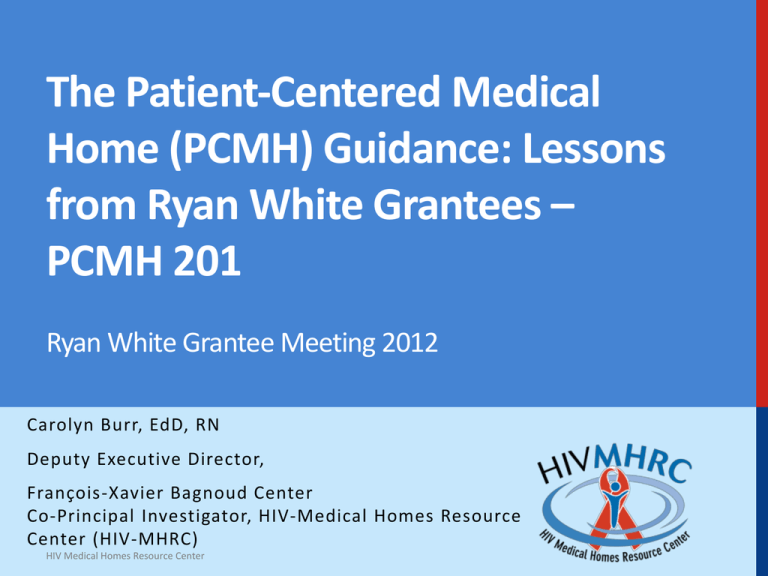
The Patient‐Centered Medical
Home (PCMH) Guidance: Lessons
from Ryan White Grantees –
PCMH 201
Ryan White Grantee Meeting 2012
Carolyn Burr, EdD, RN
Deputy Executive Director,
François-Xavier Bagnoud Center
Co-Principal Investigator, HIV-Medical Homes Resource
Center (HIV-MHRC)
HIV Medical Homes Resource Center
Lessons from the Field Panelists – AGM
Ruby Chapman, RN, BSN
Harris Health System, Houston, TX
Beverly Lawrence
Inova Juniper Program, Springfield, VA
Rondalya DeShields, RN, BSN
University Hospital, Newark, NJ
HIV Medical Homes Resource Center
Disclosures
This continuing education activity is managed and
accredited by Professional Education Service
Group. The information presented in this activity
represents the opinion of the authors or faculty
neither PESG, nor any accrediting organization
endorses any commercial products displayed or
mentioned in conjunction with this activity.
Commercial support was not receive for this
activity.
HIV Medical Homes Resource Center
Disclosures
Carolyn Burr, EdD, RN has no financial interest or
relationships to disclose.
Ruby Chapman, BSN has no financial interest or
relationships to disclose.
Beverly Lawrence has no financial interest or
relationships to disclose.
Rondayla DeShields, RN, BSN has no financial
interest or relationships to disclose.
HIV Medical Homes Resource Center
Learning Objectives
By the end of this session participants will be able
to:
Share lessons learned and strategies used by
Ryan White HIV/AIDS clinics/practices who have
successfully become certified as PCMHs
Discuss barriers and facilitators to changing
practice to become a PCMH
Discuss resources and tools available to support
this change process.
HIV Medical Homes Resource Center
Obtaining CME/CE Credit
If you would like to receive continuing
education credit for this activity, please visit:
http://www.pesgce.com/RyanWhite2012
HIV Medical Homes Resource Center
Patient-Centered Medical Home Institute
Ryan White All Grantees Meeting 2012
101
Session
The Patient-Centered Medical Home
Guidance: A Model of Care Delivery
for People Living with HIV
Tuesday 11/27/12
10 am
201
Session
The Patient-Centered Medical Home:
Lessons from Ryan White Grantees
Tuesday 11/27/12
1:30 pm
301
Session
The Patient-Centered Medical Home:
How Will We Know When We Get
There?
Wednesday 11/28/12
10 am
HIV Medical Homes Resource Center
What is a Patient-Centered Medical/Health Home
(PCMH)?
A model for delivering primary care
Personal primary care provider (PCP)
PCP directed medical practice
Whole person orientation
Care coordinated and/or integrated
Hallmarks: quality and safety
Optimal outcomes / care planning process
Evidence-based / standards of care
Accountability for CQI
HIV Medical Homes Resource Center
Change Concepts for the PCMH
Engaged Leadership
Quality Improvement Strategy
Empanelment
Continuous and Team-based Healing Relationship
Organized, Evidence-Based Care
Patient-Centered Interactions
Enhanced Access
Care Coordination
Wagner, EH et al, Guiding Transformation: How Medical Practices Can Become Patient-Centered Medical Homes; February, 2012
Overview of “Lessons From the Field”
Colleagues who have been through the PCMH
certification process
Real life examples of implementing practice
transformation
Providers from a range of RW grantees – health
departments, academic medical centers,
community health centers
HIV Medical Homes Resource Center
How are new ideas or procedures adopted
into practice?
Diffusion of Innovation Theory
Knowledge
Persuasion
Decision
Implementation
Confirmation
EM Rogers 1962
Rationale for the LFF Panel
Provides models for practice change
Identifies the impact of adopting PCMH
Opportunity to share unexpected learning –
“What I wish I’d known”
Provides practical advice for the documentation
required
Colleagues’ positive experiences increases
motivation
HIV Medical Homes Resource Center
Selection Criteria for LFF Panelists
Needs Assessment data from the agency
Certified as a Primary Care Medical Home
Ryan White funding from multiple Parts
Type of practice: HIV-specific, FQHC, academic
Examples of successful practice change
Key informant interviews
Motivation for becoming PCMH
Impact of RW on PCMH application process
For AGM – the real-time experience of the process
HIV Medical Homes Resource Center
Lessons from the Field
HIV Medical Homes Resource Center
Patient Centered Medical Home
Thomas Street Health Center: How We Got To The Winner’s Podium
Ruby Chapman, BSN RN
Nursing Coordinator
HIV Services
Thomas Street Health Center
Patient Centered Medical Home
Thomas Street Health Center: How We Got To The Winner’s Podium
Ruby Chapman, BSN RN
Nursing Coordinator
HIV Services, Thomas Street Health Center
FACT SHEET
•
•
•
Harris Health System’s 16
community health centers
comprise the largest
network of public primary
care clinics in Texas.
Harris Health unites those
with seven school-based
clinics, a dental center,
dialysis center, five mobile
health units, and three
hospitals.
Smith Clinic, opened in Fall
2012, provides specialty
outpatient services.
•
•
Harris Health System
provides for more than one
million outpatient clinic visits
a year.
Harris Health also provides
teaching facilities for Baylor
College of Medicine and The
University of Texas Health
Science Center at Houston
(UT Health).
FACT SHEET
VOLUME STATISTICS - FY 2012
• Hospital admissions 35,343
• Births (babies delivered) 6,643
• Emergency visits 173,263
• Outpatient clinic visits 1,054,770
FACT SHEET OUR LOCATIONS
FACT SHEET
COMMUNITY HEALTH PROGRAM
• Sixteen (16) community health centers, including
the nation’s first freestanding HIV/AIDS treatment
center
• One free-standing dental center
• Seven school-based clinics
•
Fifteen (15) homeless shelter clinics
• Immunization and medical outreach program with
five (5)mobile health units
Thomas Street Health Center
History
1989, first free-standing
HIV clinic in US
2011, serviced 5,483
unduplicated clients
Southern Pacific
Railroad Hospital
3,732 Male (68%)
1,751 Female (32%)
Services provided on site
•
ENT, Endocrinology, Neurology,
Psych, Dermatology, Oncology,
Rheumatology, MCM, OB/Gyn,
Anal Dysplasia, Hep C
Thomas Street Health Center
Age Categories
Count
%
13-24
225
4%
25-44
2321
42%
3% 4%
13-24
25-44
42%
50%
45-64
2757
50%
65 & Over
180
3%
5483
100%
45-64
65 & Over
WHAT EVENT AND WHAT COLOR MEDAL
WHAT COLOR MEDAL ???
How Do We Prepare???
Decide on the
accrediting agency
Know the rules for
participation
Develop a strategy
for reaching the
goal
How Do We Prepare???
Select those who
know the most
about the
organization,
processes, policies
and procedures
Involve those
committed to be the
best at what they
do
How Do We Prepare???
Collaborate –you
cannot do it along
Make sure all
participants are
motivated to get
the job done
Who will lead your
your team???
Ruby Is Our Athlete PCMH Event
She has competed on
many other Olympic teams
30 plus years as RN
20 plus years in quality
performance improvement
Previous Joint Commission
liaison
Lead IT educator with EMR
rollout
Patient education
Management
Patient Centered Medical Home Decathlon
Our Athlete Skill Set
Our Athlete Skill Set
•
Quality Management
•
Utilization Review
•
Performance
Improvement
•
Joint Commission Liaison
•
Management (leadership)
Interpretation of
standards
•
Project Management
•
Interpersonal and Coaching
Skills
•
•
EMR Super-user
•
Clinical background
Ruby PCMH Decathlon Competitor
100 METERS
NEED FOR A QUICK
START
DISCUS THROW
ABILITY TO RID
POLE VAULT
ABILITY TO LEAP OVER
JAVELIN THROW
ABILITY TO FOCUS IN A
SPECIFIC AREA
400 METERS
STRENGTH AND
ENDURANCE ABILITY
Ruby PCMH Decathlon Competitor
100 METERS HURDLES
NEED FOR A QUICK START
AND JUMP OVER
(overcome barriers)
LONG JUMP
LONG EXTENDED HOURS
SHOT PUT
ABILITY TO MEET OR
EXCEED TARGET
HIGH JUMP
ABILITY TO REACH ABOVE
OBSTACLES
1500 METERS
ABILITY FOR ENDURANCE AND
TO KEEP GOING THE
DISTANCE REQUIRED TO WIN!!
Training Schedule (Timeline)
March 15, 2011 (notification)
March 25, 2011 introduction to staff
April
Initial training
Development of template for notes in EMR
Development of forms
Training Schedule (Timeline)
May
Initial chart review access compliance
Refinement of documents
Review and revision of policies and
procedures
Training Schedule (Timeline)
June
Ongoing meetings with coordinator
Development of forms
Assessment of implemented processes
July
Continued meetings
Chasing staff, running marathon
August
36 records reviewed for submission
Notification missing document
WE RECEIVED THE GOLDMEDAL !!!
E-mail notification 9/16/11@ 4:21 pm
We are happy to acknowledge that the following application(s) have been successful and have been
granted Recognition:
Harris County Hospital District - Thomas Street Health Center
PPC-PCMH 9/12/2011 - 9/12/2014
Program Level: Level 3
Barnett, Ben MD
Giordano, Thomas MD
Jaffe, Penny MD
Krucke, Gus MD
Serpa-Avarez, Jose MD
Congratulations on your success and thank you for doing your part to advance quality in health care.
Sincerely,
Mina L. Harkins
Assistant Vice President, Recognition Programs
National Committee for Quality Assurance
Follow NCQA on Twitter
What Do You Need To Win
You Can Do It
“Pick battles big enough to matter, small
enough to win”. ~Jonathan Kozel
“Do what you can, with what you have, where
you are”. ~Theodore Roosevelt
Olympian Team Members
Irma Alvarado-Samaniego, PhD, RN
Thomas P. Giordano, MD, MPH
Pete Rodriguez, RNBSN, ACRN
Kimberlynn Luke MBA/HCA, RN
Questions
Thanks
Ruby Chapman, BSN RN
Nursing Coordinator Thomas street Health
Center
Ruby.Chapman@harrishealth.org
Inova Juniper
Beverly Lawrence
Starting at the Beginning
Rondayla DeShields, RN, BSN
Infectious Disease Practice
University Hospital
Newark, NJ
How did you start the process? Steps?
• Leadership attended a 2 day training
• Selection of an agency to secure certification
– NCQA
• Educated the providers and staff to obtain their
buy-in
• Selected a CORE Team to work on initiative
– Who and what roles are the best fit for the team?
– Creation of Team Charter
• Established a Strategic (STRAT) Group to assist with
handling barriers and resolving challenges
Steps continued…
Reviewed NCQA materials, standards and
elements with providers/staff
Performed a Readiness Assessment of the
practice
Identified areas of weakness
Results shared with CORE/STRAT teams
Development of workgroups, work plan, timeline,
and resources
Who are the key players?
Medical Director and Manager
Ambulatory Care Administration
HIT
Providers/Staff (physicians, nurses, medical case
managers, dietitian, medical technicians, front
desk personnel)
What are the biggest barriers? Facilitators?
Barriers
• Staff Turnover (positive and negative)
• Staff availability for meetings
• New EMR implementation deferred
• Current EMR is limited
– Unable to make changes/additions
– Unable to perform E-prescribing
Facilitators
• Working in a patient centered model
• Management and Staff with longevity
What is the impact of being a Ryan Whitefunded agency?
Provides primary medical care to population
Has a Patient centered model
Addresses Patient Satisfaction
Set Continuous Quality Improvement Program
Performance HAB Measures
Lessons from the Field Panel: Questions
1. How did you start the
process? What motivated
your agency?
7. What is the biggest reward
for becoming a PCMH?
2. Who were the key players?
8. How did you start the
transformation?
3. What were the biggest
barriers? Facilitators?
9. How has staff satisfaction
changed?
4. What was the impact of
being a Ryan White-funded
agency?
10. How did you keep your
team motivated?
5. How have patients
responded?
6. What was the best advice
you received? Best tool?
HIV Medical Homes Resource Center
11. How long did the process
take?
12. What do you know now
that you wish you had
known early in the process?



